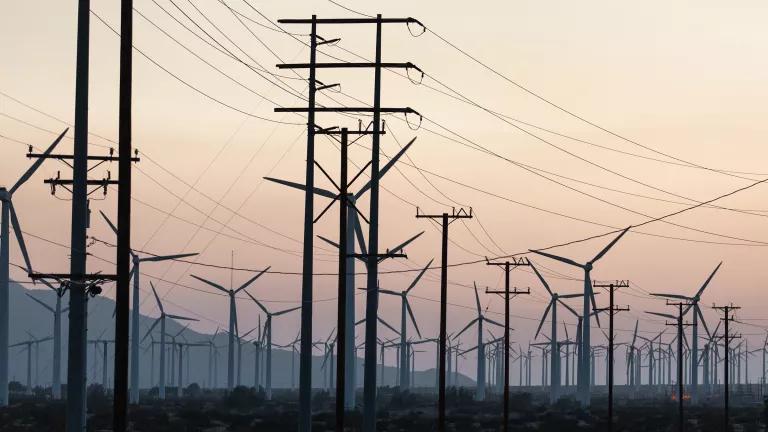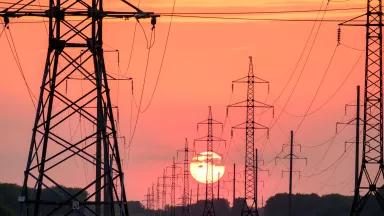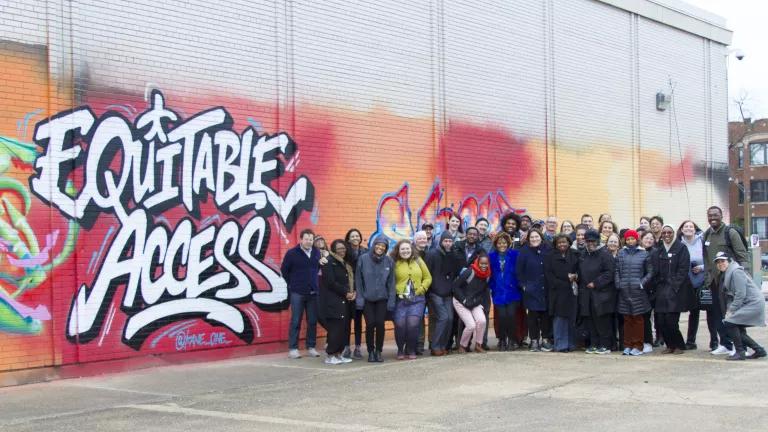FERC Takes Important Steps to Improve Siting of Transmission Lines
There is an urgent need to quickly build large-scale transmission projects. Federal backstop siting authority is one tool to get it done.

Overhead power lines and wind turbines silhouetted against a sunset sky
Matthew Spaulding/Stocksy
If you’re hearing more about the importance of electric power lines as the United States moves toward a clean energy future, you’re not alone. In recent months, The Economist and Mother Jones have explored the issue with front-page stories while the New York Times editorial board weighed in to underscore the critical need for speedier development of critical energy infrastructure.
According to the REPEAT Project, the pace of transmission expansion must more than double its rate from the past decade to unlock the full emissions reduction potential of the Inflation Reduction Act. Longer, higher-capacity transmission lines can provide grid operators access to potentially lifesaving electricity resources when generators are knocked offline during extreme weather or other events—boosting reliability and grid resilience. And studies have shown that large, interregional transmission lines can reduce consumer costs.
There is an urgent need to quickly build these large-scale transmission projects and to do so in a manner that prioritizes community engagement and environmental review. States generally have the authority to site and permit transmission lines, which is appropriate, given that states often have the clearest view of their needs. But problems can arise when individual states are asked to evaluate the regional and interregional benefits of large multistate lines, without the visibility or authority to consider the full benefits.
One tool being considered to break through this interstate coordination barrier is federal backstop siting authority, which gives the Federal Energy Regulatory Commission (FERC) authority to approve certain power lines in U.S. Department of Energy (DOE)–designated National Interest Electric Transmission Corridors when states reject or fail to act on a transmission project. Congress and President Biden have taken steps in recent years to strengthen FERC’s backstop siting authority. And the DOE has begun to lay the groundwork by issuing a draft Needs Study showing that capacity constraints and congestion on the nation’s electric transmission grid have created a pressing need to build vastly more new regional and interregional transmission. Interregional transmission boosts reliability, supports electrification efforts, improves access for renewable resources, and reduces costs for consumers. The Needs Study will help the DOE designate corridors through which FERC can permit transmission lines. The DOE plans to issue the final results of its study this summer and provide guidance on how it will designate national corridors by this fall.
Now it is FERC’s turn to update the rules governing how it will site transmission lines in DOE national interest corridors in a way that shortens the review process and ensures robust community engagement and environmental review. In comments recently submitted to FERC, NRDC and other partner organizations supported FERC’s proposed rule and provided commonsense amendments to improve its proposal. Getting transmission permitting right, from the start, combined with early engagement with communities that encourages meaningful input is a win-win-win. Developers will face less legal risk and more certainty, communities will have their concerns heard and weighed in the decision-making, and the transmission needed to usher in a clean energy transition can be built while minimizing ecological impacts.
FERC has taken important steps toward this goal. The proposal incorporates the requirement that developers act in good faith in developing transmission—a bedrock principle that will enhance community trust in the process and encourage constructive discussions between community members and developers over local concerns. FERC has also established clear expectations for how developers should engage with communities through its proposed project participation plan, Environmental Justice Public Engagement Plan, and Standards of Conduct. In addition, FERC’s proposed Tribal Resources Report and Environmental Justice Resource Report are a valuable recognition of the agency's duties to consider the "human environment" under the National Environmental Policy Act.
Still, the proposed backstop siting rule should be strengthened in several straightforward ways:
- FERC must ensure that the good faith requirements in the rule extend to all interested parties as required by the Federal Power Act and not only affected landowners.
- While the proposal enhances the ability of affected communities to participate in the permitting process, there are some easy changes that FERC should make to its Standards of Conduct, notification requirements, and Landowner Bill of Rights to better enable affected communities to provide input and fully participate in the permitting process. It is particularly important that the documents provided to landowners and others contain clear language concerning their rights and obligations, especially concerning FERC’s processes, deadlines, and the fact that residents can lose their rights if they do not intervene or seek rehearing.
- FERC should strengthen provisions in the proposal that aim to improve how it solicits and considers input from Indigenous Peoples and environmental justice communities. This includes developing a separate tribal public engagement plan and creating an environmental justice liaison.
- To ensure an efficient process, FERC should clarify how it will cooperate with other agencies in the permitting process.
What’s next?
It is clear that momentum is building around this issue. Congress has acted and the DOE and FERC have taken important steps, although there is still work to do. NRDC and partner organizations submitted comment on the DOE’s Needs Study, and the agency is collecting comments on its proposed process to designate corridors. The DOE will need to quickly finalize both before FERC can site any transmission through using backstop authority. FERC should also work to quickly finalize and strengthen its backstop siting rules. Only through a transparent process that is trusted by all parties can transmission developers, communities, and others find common ground and ensure that the United States builds the transmission it desperately needs for a cleaner, more robust, and affordable grid while respecting the needs of communities and the environment.
This blog provides general information, not legal advice. If you need legal help, please consult a lawyer in your state.






